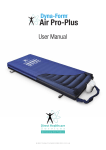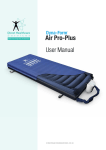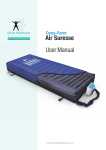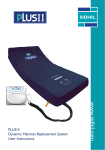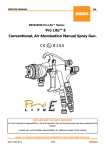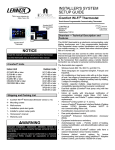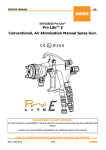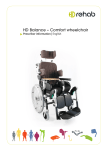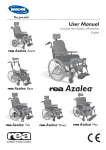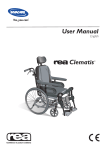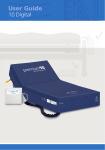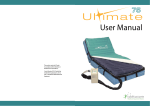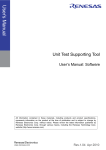Download DHS - User Manual Air Plus 2.indd
Transcript
Contents Important Notice Before operating this medical equipment, it is important to read this manual and understand the operating instructions and safety precautions. Failure to do so could result in patient injury and/or damage to the product. If you have any questions, please see contact information on cover. Safety Precautions.......................................... 3 Product Overview............................................. 4 Installation.......................................................... 5 Unpacking & Inspection.................................. 5 Installation Guide.............................. see cover Operation................................................................ 6 Control Unit Panel............................................ 6 Alarm Functions................................................ 7 Mattress Function............................................. 8 Removal & Transport Function...................... 9 Troubleshooting.............................................10 Cleaning................................................................12 Maintenance.......................................................14 Warranty Information................................15 Technical Specifications.................. see cover 1 2 SAFETY PRECAUTIONS In General Control Unit Do not use this equipment in the presence of flammable anesthetics. Explosions could result. The control unit is tested and approved according to ISO-EN 60601-1 rev.2 & EMC Bed frames used with the systems can vary greatly depending on the specific health care setting (i.e. hospitals, nursing homes, home care, etc). It is the responsibility of the caregiver to take the necessary precautions to ensure the safety of the patient. This includes, but is not limited to, the appropriate use of side rails to prevent falls and/or patient entrapment. Minimize articles between the system surface and patient, and secure bed sheets loosely so as not to affect the alternating cell movement. The manufacturer does not require such preventive inspections by other persons. The user must check that the equipment functions safely and see that it is in proper working condition before being used. No special skills or training of the operator is required. there is no restriction on the location or the environment. Significant risks of reciprocal interference may be posed by the presence of the system during specific investigations or treatments. Potential electromagnetic or other interference bewteen the system and other device may occur, if interference is suspected, move equipiment from sensitive devices or contact the manufacturer. Preventive inspection and calibration is not required. Do not modify this equipment without authorization of the manufacturer. Manufacturer will provide circuit diagrams, component part lists, descriptions to assist to service personnel in parts repair. The mattress is treated as the applied part. Unplug the control unit from the mains power supply to disconnect the power. Only plug into a grounded power receptacle and use the power cord supplied with the system. Exposure of the electronic Control Unit to any liquid while it is plugged in could result in a severe electrical hazard. Only use fuses that have the same specified rating. Using fuses with higher ratings could result in damage and/or injury. (See Technical Specifications on cover). The electronic Control Unit is a precision electronic product. Use care when handling or transporting. Dropping or other sudden impacts may result in damage to the unit. Do not open the Control Unit – risk of electrical shock. Do not attempt to repair or service the Control Unit. Repairs and service should be conducted by an authorised local distributor. (See contact information on cover). If the Control Unit is not functioning properly, or has been damaged, unplug the unit and take it out of service immediately. (See contact information on cover for repair and service information). Do not place any objects or items, such as blankets, on or over the Control Unit. The power cord to the Control Unit should be positioned to avoid a tripping hazard and/ or damage to the cord. It is recommended to place the cord under the bed frame and attach it to an electrical outlet by the head of the bed. Do not position the system so that it is difficult to operate the disconnection device. 3 Product Overview Alternating Mattress System (see cover) Dyna-Form Air Pro-Plus is an alternating Mattress Replacement system providing pressure application and release to patients with, or vulnerable to, pressure ulcers. It is designed to replace an existing mattress and can be used on Control Unit The Control Unit provides the air supply to the Mattress. • It is controlled via a touch panel with integrated digital display. The Alarm sounds both standard and profiling bed frames. when pressure fails or power is interrupted. Mattress Alarm Mute silence the alarm for maximum This system includes a static head cell(s) to of 20 minutes – the alarm resumes if cause provide static “pillow” support for optimum user of failure is not resolved. The Alarm will comfort, while air pressure in the other cells sound for up to two hours following an is alternated over a 10 -12 minute cycle. This interruption to power. provides regular periods of pressure reduction •The Control Unit includes a back up to aid blood and lymphatic flow to vulnerable power battery for the alarm. This battery is tissue. continuously re-charged will last the life time of the product. • Buttons on the control panel adjust the three comfort level settings. •The Alarm LED indictor and Alarm Mute completes the profile. The visible and audible alarm functions has a number of indications depending on the cause of the failure. The mains supply to the Control Unit can be easily disconnected and is designed to detach if tugged too firmly - protecting the internal wiring of the unit. Should this occur, the alternation sequence is suspended and the Mattress cells remain inflated and/or deflated based on the current cycle. The Power Down Alarm will sound. (See picture on inside cover). 4 Installation Unpacking & Inspection (see cover) It is recommended that all packing materials and instructions be kept in the carry bag provided in the event the product has to be shipped to Direct Healthcare or an authorised local Direct Healthcare distributor. Please see contact information on cover. Carefully remove the Control Unit, Mattress Replacement and accessories from the shipping cartons. Inspect all items for any damage that may have occurred during shipping. Any damage or missing components should be reported to Direct Healthcare or an authorised local Direct Healthcare distributor as soon as possible. Please see contact information on cover. 5 Operation Control Unit Panel (see inside cover) A Power Button Turns system power on and off by pressing the Power button for at least two seconds. B Alarm LED *A,B & C One of *these red light flashes, and an audible alarm sounds, to alert when Control Unit or Mattress Replacement pressure fails. The alarm the previous pressure setting for patient safety. Static Mode will automatically revert to Alternation Mode after one hour for patient safety. F Static Function Button Press to facilitate static mode for clinical has three different signals to indicate the cause procedure / patient transfer purposes. After of the failure (see over) 20 minutes, the system automatically reverts The audible alarm also sounds when power is switched off – press Alarm Mute to silence. C Alarm Mute Button Silences the audible alarm (on / off ). Audible alarm will resume after 20 minutes if cause of failure not resolved. D Pressure Buttons (Soft, Medium & Firm) Press buttons to increase or decrease pressure setting. The Soft Medium & Firm settings allow comfort to the user, without clinical compromise. The green LEDs illuminate to indicate which of the three settings is operational. E Dynamic Function Button Press Dynamic Mode for alternative cells cyclically inflating and deflating. Static Mode will automatically revert to Alternation Mode after one hour for patient safety. Upon power up, the system automatically 6 reverts back to the dynamic mode operating at back to the previous pressure setting for patient safety. Press Static Mode for all cells to be fully inflated with no dynamic alternation. Static Mode will automatically revert to Alternation Mode after one hour for patient safety. G Control Unit Lock / Unlock Button Press for at least two seconds to lock the Control Unit settings – a beep sounds and the amber LED illuminates to indicate system is locked. When locked, only the Alarm Mute and Lock / Unlock buttons remain operational. Press again for at least two seconds to unlock (beep sounds and amber LED turns off ). The Control Unit will automatically unlock in the event of a power failure. OPERATION Alarm Function The red Alarm LED (A,B or C) flashes, and an audible alert sounds, to indicate the control unit or mattress pressure has failed. The LED will remain illuminated until appropriate pressure is restored. The audible alarm can be silenced by pressing the Alarm Mute button. The system has three different alarm signals, identified by illumination sequences. A B C The signals and corresponding Pressure Setting LED displays are illustrated below. Display Alarm Signal High pressure The system cannot reach the set pressure within 8 minutes. The system pressure is to high. Low pressure The system cannot reach the set pressure within 8 minutes. The system pressure is to low. Mains Failure Power unit has no power feed. A B C A B C A B C If alarm activates and the system fails to inflate or loses pressure, refer to Troubleshooting on following pages. 7 Operation Mattress Function Establishing Pressure (supine patient) With the patient lying supine (on their back, Establishing Pressure (inclined patient) face upwards), use the Pressure arrows to When moving the patient to a sitting or more cycle through the eight available pressure upright position, pressure may need to be settings. increased to a medium or firm setting in order to Based on patient weight and comfort provide added support and to avoid ‘bottoming requirements, establish the best setting for out’. effective alternation, support and comfort. It is important to return to the original pressure setting when the patient returns to the supine position. Before changing or lowering the pressure, ensure the system is working effectively by performing a ‘bottoming out’ test: Bottoming Out Test Wait a minimum of 12 minutes between pressure adjustment and patient assessment, as it may take a cycle for the system to adjust. When altering the pressure setting, ensure the patient is not ‘bottoming out’ (insufficiently supported by the air cells and therefore coming in contact with bed base). 1. Ensure system is in alternation mode but is not undergoing an alternation. 2. With the patient lying in a supine position, CPR Function Rapid deflation of the Mattress may be required for emergency treatment or to decommission the system. Firmly pull the Rapid Release /CPR Handle from the side of the Control unit to rapidly deflate the entire system. unzip top cover just past sacral (bottom) To re-inflate the system after the Rapid Release region. /CPR Handle has been removed replace as 3. Slide your hand along a deflated cell under such, ensuring all sealing connectors are firmly the patients sacral area (bottom). The inner attached and restart the Control Unit. Wait for the static cell will remain inflated but your hand Mattress system to gain optimal pressure. should slide easily between patient and Perform a Bottoming Out test after inflating the base. mattress following rapid deflation. 4. If a hand can pass under patient then the patient is adequately suspended and pressure can be lowered. 5. Repeat Bottoming Out test after pressure has been lowered. Mattress replacement / Overlay Function The mattress body of the Air Pro-Plus can be used as a mattress replacement system or as an overlay system. The standard delivery status is as a In the event of a system malfunction, the alarm mattress replacement system. To use the Air Pro-Plus will activate and pressure LEDs will flash. as an overlay system, zip off the bottom part of the mattress body which holds the foam base. Once the bottom part is removed, the mattress body can be placed on a standard hospital mattress before patient use. 8 Operation Transport Function System Removal 1.Before patient transport, switch modes 1. Turn off the Control Unit by pressing the from alternating to static and wait for 10 Power button for at least two seconds and -12 minutes for cells to inflate to maximum unplug the power cable. pressure. 2.Turn off the Control Unit. 3.Remove the mattress connection from the 2.Remove the Rapid Release Handle from the Control Unit. 3. Place Control Unit and power cable on top Control Unit. Allow air to escape for a few of the Mattress and detach Mattress from seconds before sealing with the attached the bed frame. transport cap, see picture on cover. This will soften the Mattress surface for pressure relief and comfort. Air can be seal in the system for 30 hours as a transport feature. If the patient is responsive, check comfort level based on current pressure and adjust 4.Once air has been released from all cells, roll up the Mattress and return all items to Carry Bag for safe keeping. Prior to re-starting the system, ensure the Rapid Release Handle is firmly connected to the Control Unit. accordingly. Always perform a ‘bottoming out’ test (see page 8) to ensure the patient is adequately supported and not touching bed base. 9 TROUBLESHOOTING Alarm/Fault Cause Solution Control Unit does not The Control 1. Check the Control Unit is connected to mains power operate; no display Unit may not be lights illuminate attached to a power source or a fuse may need replacing outlet with the correct voltage. 2. Check the Control Unit is switched on. Switch off and unplug the unit before restarting. 3. Check the mains plug fuse (3 AMP) then check both Control Unit fuses (1 AMP) – fuses can be released using a screwdriver to push and turn. Do not try to open the Control Unit. Opening the unit could cause personal injury or equipment damage. Ensure the replacement of fuses is carried out accordance with local legislation. Alarm LED C Mains failure / Other (see above plus>) + audible alarm 1. Reset the alarm -turn off power and press the alarm mute button. 2. Check the handle is intact, ensuring all four sealing connectors are firmly fitted to the control unit and the air hoses. Check the CPR tag is attached and all sealing connectors are firmly secure. 3. Check all air hoses along the inside of the mattress -each should be firmly connected. Check each air cell is securely attached to its connecting air pipe. 4. Check all cells, pipes and hoses for any air leakage. 5. Switch on power. A B C Alarm LED B + audible alarm A B C 10 Pressure too low 1. Reset the alarm -turn off power and press the alarm mute button. 2. Check the handle is intact, ensuring all four sealing connectors are firmly fitted to the control unit and the air hoses. Check the CPR tag is attached and all sealing connectors are firmly secure. 3. Check all air hoses along the inside of the mattress -each should be firmly connected. Check each air cell is securely attached to its connecting air pipe. 4. Check all cells, pipes and hoses for any air leakage. 5. Check that the air filter cover is correctly secured and the air filter is clean. 6. Switch on power. TROUBLESHOOTING Alarm/Fault Cause Alarm LED Pressure too high A + audible alarm Solution 1. Reset the alarm -turn off power and press the alarm mute button. 2. Disconnect the air hoses to reduce pressurereconnect when pressure has decreased. 3. Check for twists in the air hoses between Mattress and Control Unit. 4. Switch on power. A B C Other checks to consider as below: Alarm LED Alternating Any Mode Failure + audible alarm Alarm LED (no alternation) 1. Reset the alarm – turn off Power and press the Alarm Mute button. 2. Disconnect the air hoses to reduce pressure – reconnect when pressure has decreased. Power down 1. Press the Alarm Mute button to silence the audible alarm. Any 2. Check the power cable is firmly plugged into the + audible alarm mains outlet and the Control Unit; and check the mains power is switched on. 3. Check the Control Unit fuse (1 AMP) – fuses can be released using a screwdriver to push and turn. Patient is sinking The pressure may or “bottoming out” be set too low whilst lying flat on the for the patient’s Mattress Replacement weight 1. Increase the pressure setting by pressing up the Pressure arrow. 2. To check effective system performance, conduct a “bottoming out” test as described on page 8. If the problem is not resolved, please contact Direct Healthcare or an authorised local distributor. See contact information on cover. 11 Cleaning Before the cleaning and disinfection procedure, please use hygienic hand disinfection with an alcoholic skin disinfectant. To protect clothing, use plastic apron, face mask and gloves. Infection Control and routine cleaning must Mattress Base Wipe down the outside shell with authorised cleaning and disinfection solutions, ensuring that all surfaces come in contact with the disinfectant. Rinse off well with a clean damp cloth and air dry. Should Air Cells require disinfecting, disconnect be carried out in accordance with your local Air Cells from the base by unfastening the press Infection Control Policy. It is suggested that studs at each end and disconnecting air pipes all disinfection be done with a high grade from main air hoses before sliding each cell disinfectant in accordance with manufacturer’s out from the cell straps. Swab with authorised instructions. cleaning and disinfection solutions. Dry thoroughly with a soft cloth before refastening. Use authorised cleaning and disinfection solutions only! The working table and the system must be cleaned and disinfected. Concentration and exposure time of the solutions must be noted! The top cover seams are sealed to prevent moisture ingress and bacterial growth in the seam stitching. Do not use high temperature autoclave, or use Phenolic based products for cleaning. It is recommended the system is cleaned between patients and approximately every two weeks if in constant use. Refer to the cleaning and disinfection information for the Air Pro-Plus system for additional guidance. In case of questions in hygiene please contact an authorised local Direct Healthcare distributor. 12 Do not machine wash or dry the Air Cells or Mattress base. Do not disassemble the Mattress unless cleaning is required. If cleaning or disinfecting is required, do not disconnect the pipes from individual Air Cells. CLEANING Top Cover Handle Refer to the top cover wash tag for cleaning instructions. The exterior of the Handle can be periodically wiped using a cloth a dampened with authorised cleaning and disinfection solutions. If there are visible signs of body fluids and or substances present, the top cover should be washed. Top covers can be machine washed (up to 95ºC) using authorised cleaning and disinfection solutions. To establish the amount of disinfectant to use, determine the amount of water in the washer and then follow the manufacturers’ instructions for dilution. Soak the top cover in the disinfectant during the wash cycle. Rinse well in clean water and dry thoroughly before use. Do not dry the top cover using too high a heat cycle (see Dartex technical recommendations - up to 95ºC ). Air dry if possible or select a n appropriate heat dry cycle within limits as above. If there are no visible signs of body fluids and or substances on the top cover, the top cover should be sanitized and rinsed with fresh water accordingly. Control Unit Ensure the Control Unit is disconnected from the mains electricity supply before cleaning. Do not spray disinfectant directly on to the Control Unit, or immerse the Control Unit in any type of liquid. This could result in a severe electrical hazard as this equipment has no protection against ingress of water. This equipment is not suitable for use in the presence of a flammable anesthetic mixture with air or with oxygen or nitrous oxide. Wipe down Control Unit with warm water containing detergent (or authorised cleaning and disinfection solution) and dry thoroughly before use. If there are no visible signs of body fluids and or substances on the top cover, the top cover should be sanitized. 1. Apply an intermediate level authorised .. cleaning and disinfection solution to the top cover upper surface either by spraying In case of notifiable diseases clean and disinfect systems following eventually special procedures revised and published by the local health care authorities. The transport should take place in special plastic bags only. or by hand application. 2. Ensure the surface is completely covered with the disinfectant and remains in contact with the surface according to manufacturer’s instructions. 3. Remove disinfectant and rinse thoroughly. 4. Allow to air dry before use. 13 Maintenance Air Filter Replacement Fuse Replacement 1.Switch off the power supply to the 1.Switch off the power supply to the Control Unit. 2.Disconnect the power lead and air hoses. 3.Place the Control Unit on a flat surface with back panel uppermost (place soft cloth under unit to prevent scratches). 4.Carefully remove air filter cover, remove and discard the filter material and fit new filter (there may be a small locking screw – use a small Phillips Head screwdriver to remove). 5.Refit the air filter cover to the Control Unit. 2.Remove the power cord from the electrical socket on the side of the base of the Control Unit. 3.Insert a small Flat Head screwdriver into the groove and turn anti-clockwise (quarter turn). 4.Remove the “blown” fuse from the fuse holder clip and discard. 5.Insert a new fuse into the plug. Push against The Control Unit is now ready for the force of the spring and turn clockwise re-connection. with the screwdriver (quarter turn). Good filter maintenance is critical to maintain your system in optimal operating condition. Failure to keep the filters clean will result in system downtime and increase repair costs. It is recommended that the air filter be replaced annually. Replacement air filters are available from an authorised local Direct Healthcare distributor. Please see contact information on cover. 14 Control Unit. Ensure the replacement of fuses is carried out accordance with local legislation. Warranty Information This product is produced to perform in accordance with established specifications, starting from the date the product is shipped. For warranty period see Technical Specification on cover. During the warranty period repairs and replacement will be made on products that are not performing in accordance with established specifications, unless the problem/failure is due to: • customer damage, negligence and/or misuse. • unauthorised repairs. Items not covered under warranty include, but are not limited to, stains, punctures, cuts, damages to electrical cords, rips or tears, dents and/or lost/missing parts. Neither the company(See contact information on cover), its distributors, officers, directors, employees or agents shall be liable for consequential or other damages, including but no limited to personal injury, loss, or any other expense, directly or indirectly arising from the use of its products. The sole remedy for breach of the limited warranty granted herein shall be repair or replacement of the products. If you have any questions see contact information on cover. 15 Definition of Symbols Used The following symbols may appear in this manual, on the Control Unit, or on its accessories. Some of the symbols represent standards and compliances associated with the Control Unit and its use. Caution: Consult accompanying documents Class II equipment Manufacturer Serial number Type B applied part DISPOSAL: Do not dispose of this product as unsorted municipal waste. Collection of such waste separately for special treatment is necessary. Operating Instruction. 16 Declaration – electromagnetic emissions - for all ME EQUIPMENT and ME SYSTEMS Guidance and manufacture’s declaration – electromagnetic emission The MAT/PRO-PLUS/PUMP is The customer or the user of the system should ensure that it is used in such an environment. Emission test Compliance Electromagnetic environment – guidance RF emissions Group 1 The system uses RF energy only for its internal function. CISPR 11 Therefore, its RF emissions are very low and are not likely to cause any interference in nearby electronic equipment. RF emission Class B in all establishments, including CISPR 11 Harmonic emissions The system is suitable for use Class A IEC 61000-3-2 domestic establishments and those directly connected to the public low-voltage power Complies supply network that supplies emissions buildings used for domestic IEC 61000-3-3 purposes. 17 Declaration – electromagnetic immunity Guidance and manufacture’s declaration – electromagnetic immunity The MAT/PRO-PLUS/PUMP is The customer or the user of the system should ensure that it is used in such an environment. Immunity test IEC 60601 test level Compliance level Electromagnetic environment – guidance Electrostatic ±6 kV contact ±6 kV contact Floors should be wood, concrete discharge (ESD) ±8 kV air ±8 kV air IEC 61000-4-2 with synthetic material, the relative humidity should be at least 30%. Electrical fast ±2 kV for power ±2kV for power Mains power quality should be that transient/burst supply lines supply lines of a typical commercial or hospital environment. IEC 61000-4-4 Surge IEC 61000- ± 1 kV line(s) to 4-5 line(s) Mains power quality should be that mode of a typical commercial or hospital environment. Voltage dips, <5% U T (>95% dip <5% U T (>95% Mains power quality should be that short interruptions in U T ) for 0.5 cycle dip in U T ) for 0.5 of a typical commercial or hospital and voltage 40% U T (60% dip cycle environment. If the user of the in U T ) for 5 cycles 40% U T (60% dip Span system requires continued 70% U T (30% in U T ) for 5 cycles dip in UT) for 25 70% U T (30% dip cycles in U T ) for 25 cycles <5% U T (>95% <5% U T (>95% dip in U T ) for 5 sec dip in U T ) for 5 sec 3A/m 3A/m variations on power supply input lines EC 61000-4-11 Power frequency operation during power mains interruptions, it is recommended that the system be powered from an uninterruptible power supply or a battery. Power frequency magnetic (50Hz) magnetic characteristic of a typical location IEC 61000-4-8 NOTE 18 U T is the a.c. mains voltage prior to application of the test level. in a typical commercial or hospital environment. Declaration – electromagnetic immunity – for ME EQUIPMENT and ME SYSTEMS that are not LIFE-SUPPORTING Guidance and manufacture’s declaration – electromagnetic immunity The MAT/PRO-PLUS/PUMP is The customer or the user of the system should ensure that it is used in such an environment. Immunity test IEC 60601 test level Compliance level Electromagnetic environment - guidance Conducted 3 V rms 3 V rms Portable and mobile RF communications equipment RF 150 kHz to IEC 61000- 80 MHz should be used no closer to any part of the CT515, including cables, than the recommended separation distance calculated from the equation applicable to the 4-6 frequency of the transmitter Recommended separation distance Radiated RF IEC 610004-3 d = 1.167√P 3 V/m 80 MHz to 2.5 GHz 3 V/m d = 1.167√P 80 MHz to 800 MHz d = 2.333√P 800 MHz to 2.5 GHz Where P is the maximum output power rating of the transmitter in watts (W) according to the transmitter manufacturer and d is the recommended separation distance in meters (m). by an electromagnetic site survey, a should be less than the compliance level in each frequency range. b Interference may occur in the vicinity of equipment marked with the following symbol: NOTE 1 At 80 MHz and 800 MHz, the higher frequency range applies. mobile radios, amateur radio, AM and FM radio broadcast and TV broadcast cannot be predicted theoretically with the applicable RF compliance level above, the system should be observed to verify normal operation. If abnormal performance is observed, additional measures may be necessary, such as reorienting or relocating the system. 19 Recommended separation distances between portable and mobile RF communications equipment and the EQUIPMENT or SYSTEM - for ME EQUIPMENT or ME SYSTEM that are not LIFE - SUPPORTING Recommended separation distances between portable and mobile RF communications equipment and the MAT/PRO-PLUS/PUMP Alternating Control Unit The MAT/PRO-PLUS/PUMP is intended for use in an electromagnetic environment in which radiated RF disturbances are controlled. The customer or the user of the system can help prevent electromagnetic interference by maintaining a minimum distance between portable and mobile RF communications equipment (transmitters) and the system as recommended below, according to the maximum output power of the communications equipment. Rated maximum output power of transmitter (W) Separation distance according to frequency of transmitter (m) 150 KHz to 80 MHz 80 MHz to 800 MHz 800 MHz to 2.5 GHz d = 1.167√P d = 1.167√P d = 2.333√P 0.01 0.117 0.117 0.233 0.1 0.369 0.369 0.738 1 1.167 1.167 2.333 10 3.689 3.689 7.379 100 11.667 11.667 23.333 For transmitters rated at a maximum output power not listed above, the recommended separation distance d in meters (m) can be estimated using the equation applicable to the frequency of the transmitter, where P is the maximum output power rating of the transmitter in watts (W) according to the transmitter manufacturer. NOTE 1 At 80 MHz and 800 MHz, the separation distance for the higher frequency range applies. objects and people. 20




















